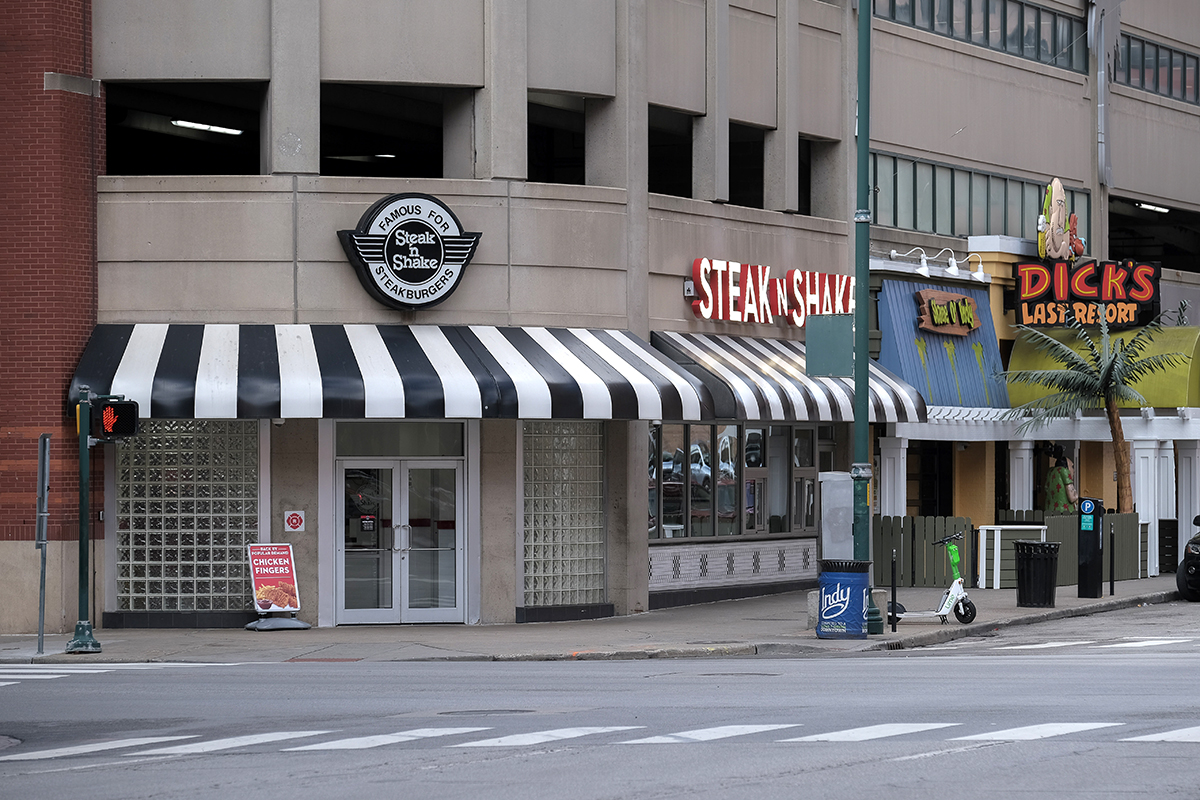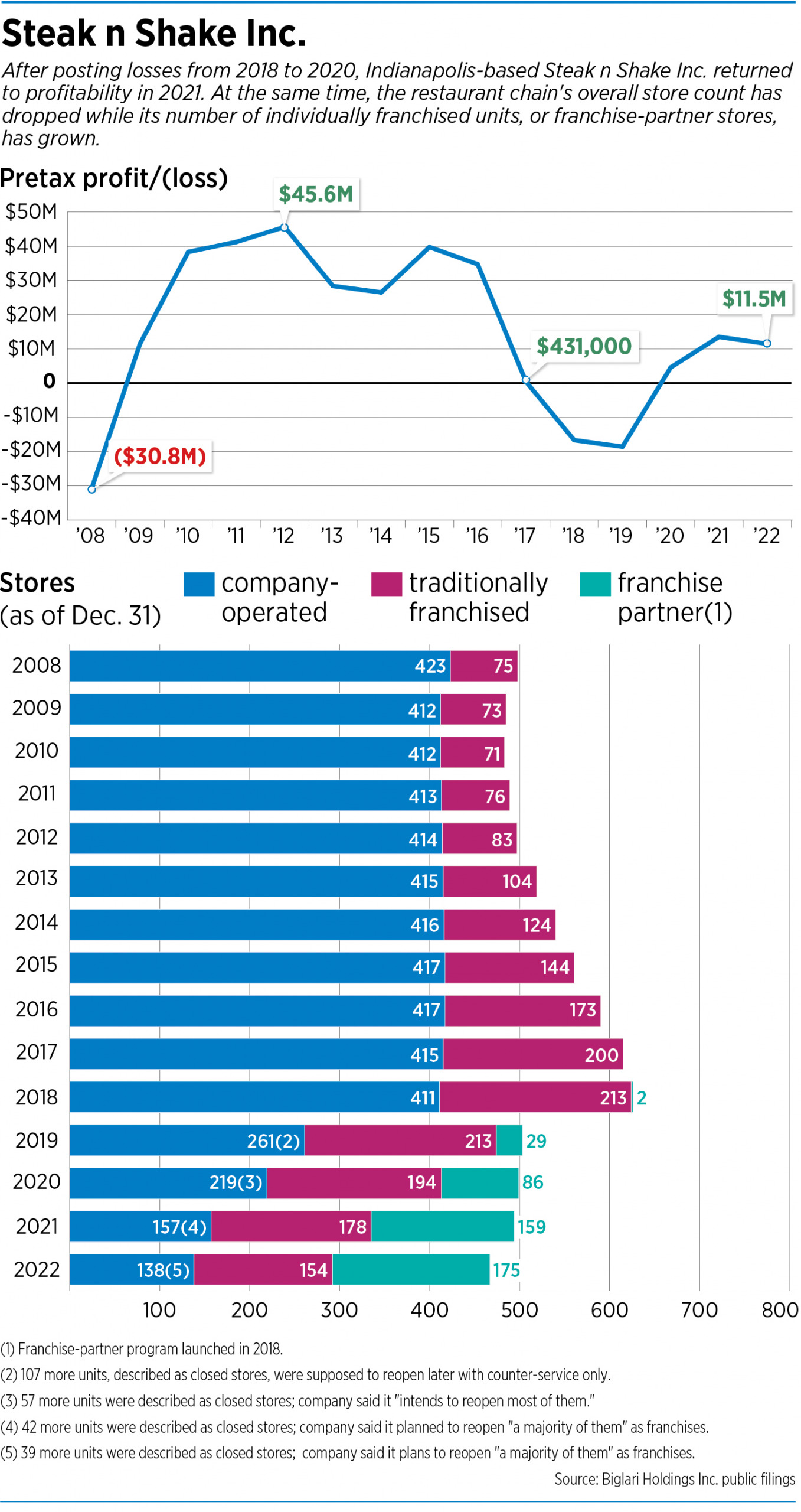Subscriber Benefit
As a subscriber you can listen to articles at work, in the car, or while you work out. Subscribe NowSince 2020, Steak n Shake has spent $50 million to eliminate table service at its restaurants in favor of self-service ordering—an investment the company says has allowed it to regain profitability after three straight years of losses.
The corporate parent of the Indianapolis-base company is San Antonio-based Biglari Holdings Inc. In his annual letter to shareholders last month, Biglari Holdings CEO Sardar Biglari said the elimination of table service was “a textbook case of adjusting the business model rather than accepting fate.”
Outside observers say, though, that it’s not yet certain the 89-year-old restaurant chain is back on solid footing.
“It’s just one of those brands in limbo,” said Jay Bandy, president of Atlanta-based restaurant consulting firm Goliath Consulting Group. “It has potential, but I just don’t think they’ve found what that is.”
It can be challenging to get a clear picture of what’s happening inside Steak n Shake. Though Biglari Holdings is a publicly traded company, Biglari himself does not speak to reporters. Phone messages left with both Biglari Holdings and with Steak n Shake’s chief marketing officer were not returned.
A local Steak n Shake franchisee said the company would not allow him to talk with IBJ unless questions were submitted in advance and the franchisee’s answers to those questions were reviewed in advance by the company.
And Biglari Holdings includes more than just Steak n Shake. The holding company’s other properties include the Western Sizzlin restaurant chain, along with insurance companies, oil and gas companies and the men’s magazine Maxim.
But some insights are available via the company’s annual report and Biglari’s annual letter to shareholders.
In that letter, Biglari said converting Steak n Shake to a self-service format has led to a dramatic boost in per-restaurant productivity. Annual sales per employee are nearly $131,000, he wrote, compared with about $64,000 under the old table-service model.
“The resultant cost savings have largely been passed on to customers through low prices, and to associates through higher wages,” Biglari wrote.
Steak n Shake’s pretax profit in 2022 was $11.5 million, down from $13.5 million in 2021 but still a turnaround from the three-year period of 2018 to 2020, when the company posted losses each year.
“Before our transformation, Steak n Shake was an old buggy-whip restaurant company,” Biglari wrote in the 2022 shareholder letter. “Its original business model did not work in the modern era. The company suffered from labor-intensive table service combined with outmoded kitchen equipment in its production line.”
The conversion to a self-service model represented a $50 million investment in a new point-of-sale system, self-order kiosks and restaurant remodelings.
Biglari also noted in his letter that Steak n Shake is “not yet earning a return commensurate with the capital employed in the business.”
More changes
Steak n Shake has also gone through other changes over the past five years.
In February 2021, the company reported that it had retired $153 million in debt. (Steak n Shake’s lenders, represented by Wilmington Trust, took the restaurant to court in April of that year, claiming the company still owed more than $8.5 million in fees and interest. That lawsuit was settled the following year.)
And a “franchise partner” program launched in 2018 has gained traction over a slow start, with 175 stores being operated by franchise partners at the end of last year. Steak n Shake’s franchise partner program allows operators to take over the full-time operation of a single corporate-owned store.
The total investment for franchise partners is estimated at $165,000 to $411,000. Franchise partners pay $10,000 of that upfront and the rest over time through store revenue. The fees are significantly less than with traditional franchise agreements, though the franchise partner is limited to one location. The partner pays the corporation a percentage of sales and profit like a traditional franchise arrangement but doesn’t own the business or have the right to transfer it.
In addition to the chain’s 175 franchise-partner locations, Steak n Shake had 154 locations operated under traditional franchise agreements at the end of 2022. The chain also operated 138 company-owned stores, with an additional 39 company-owned stores that were closed as of year-end. In its 2022 annual report, Steak n Shake said it intends to reopen a majority of the 39 locations as franchises.
Those 39 closed stores represent an improvement over recent years. At the end of 2019, faced with declining financial performance, Steak n Shake had closed 107 of its stores with the intent to reopen them.
Buck Hartzell, an Alexandria, Virginia-based investment analyst for The Motley Fool, said he sees the franchise partnership model as a good move for Steak n Shake. “They’re trending in the right direction.”
Traditional franchisees typically want to choose their own location and build a new store, Hartzell said, so they aren’t likely to be interested in taking over an existing store. “Most people want something new and shiny, if you’re laying down the bigger money.”
By recruiting franchise partners, Hartzell said, Steak n Shake can potentially reopen its existing stores without having to run the locations itself. He speculated that the company is holding onto the 39 closed stores because it likes the locations and thinks the stores can succeed if it can find the right operators.
Bandy, the Atlanta restaurant consultant, said Steak n Shake’s franchise partner program can be successful—he pointed to the Atlanta-based quick-serve chain Chick-fil-A as an example of a company that has had good results with this model.
The potential risk, Bandy said, is that franchise partners might be less likely than traditional franchisees to have the financial wherewithal to weather slow times, Bandy said. “You’re typically dealing with people who don’t have a lot of assets.”
Finding the right franchise partners can also be a challenge, said Danny Klein, editorial director at QSR, a trade publication for the quick-service restaurant industry.
The ideal franchise partner, Klein said, is someone who is content to operate a single location and who might have less restaurant experience and less capital than traditional franchisees.
“It’s a pretty unique arrangement,” Klein said of franchise partnerships. “It probably does take a lot of vetting to find this type of operator.”
In his investors letter, Biglari noted that Steak n Shake converted 16 company-owned stores to franchise partners in 2022. That was a slowdown from the 73 conversions the previous year. The slowdown was “intentional to ensure our high standards were not compromised,” Biglari wrote.
‘We’re visual creatures’
Installing the self-serve kiosks could also be a good strategy for Steak n Shake, said Jharonne Martis, director of consumer research at the business data and analytics company Refinitiv.
The kiosks can help restaurants get by with fewer employees, Martis said, which is especially significant given the tight labor market.
Those kiosks can also suggest add-on items like milkshakes and fries, showing images of treats that can be hard for customers to resist.
“It does work,” she said. “As humans, we’re visual creatures.”
Martis pointed to other quick-serve chains such as New York City-based Shake Shack, Inc. and Florida-based Burgerfi International Inc., both of which have reported good results using self-serve kiosks.
Shake Shack Inc. introduced its first self-serve kiosk at a single store in its hometown of New York City in 2017. In its 2022 annual report, filed last month, Shake Shack said it plans to add kiosks to all 254 of its U.S. company-owned stores by the end of this year. Kiosks represent Shake Shack’s highest-margin ordering channel and the highest check totals for in-store orders, the company said.
During a call with investors in November, the CEO of Florida-based Burgerfi International Inc. said 22 company-owned stores and 10 franchisee-owned stores had installed in-store ordering kiosks, and the company planned to add kiosks in more locations over time.
“Kiosks can be a high-margin channel, as they allow us to market directly to our guests, add on and upsell, ensure order accuracy, and redeploy or reduce our labor,” Burgerfi CEO Ian Baines said on the call.
Burgerfi and its franchisees operate a total of 174 restaurants under the Burgerfi and Anthony’s Coal Fired Pizza & Wings brands. The company’s Indiana presence is represented by two Burgerfi locations in Fort Wayne.
At an investor presentation in January, Burgerfi said about 25% of its on-site orders were placed through self-service kiosks—and that customers spent, on average, 12% to 14% more when ordering via kiosk.•
Please enable JavaScript to view this content.






Biglari ruined Steak’n’Shake years ago. It’s been downhill ever since he seized control, and will never be the same.
Biglari single handedly destroyed Steak & Shake. Now he wants to be praised by hooking it up to life support? Food quality cratered under his ownership as “cheap” is the only play he knows.
So is there any difference between Steak and Shake and McDonalds now, then?
McDonalds is successful.
There’s just no point in going there anymore. While the chili 3-ways is one of my favorites, it’s not relaxing and is a hassle. I tried the kiosk. It didn’t show all the options. No one could help. I left and haven’t been back.
You would have thought that someone would have been creative enough to figure out how to cash in on a retro theme – expect since it was the original.
Someone has been. They’re called Freddy’s and Culver’s. That both are growing like mad tells me that Biglari doesn’t really have a clue what he’s talking about when it comes to market segments, because that was the Steak and Shake niche that they OWNED in this market.
And, funny enough, every time I go into a Freddy’s or Culver’s, they’re packed with customers and employees. And I don’t have to mess with a kiosk computer to order.